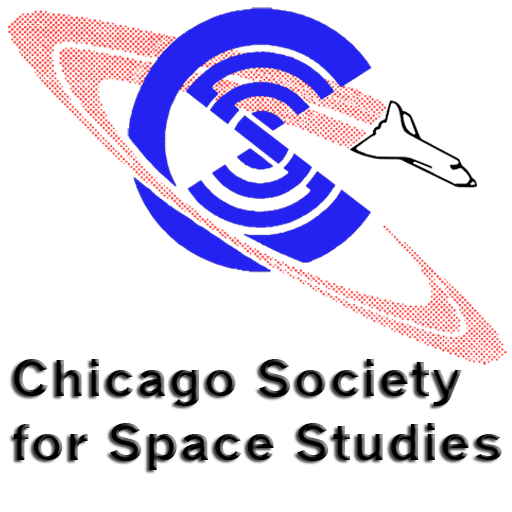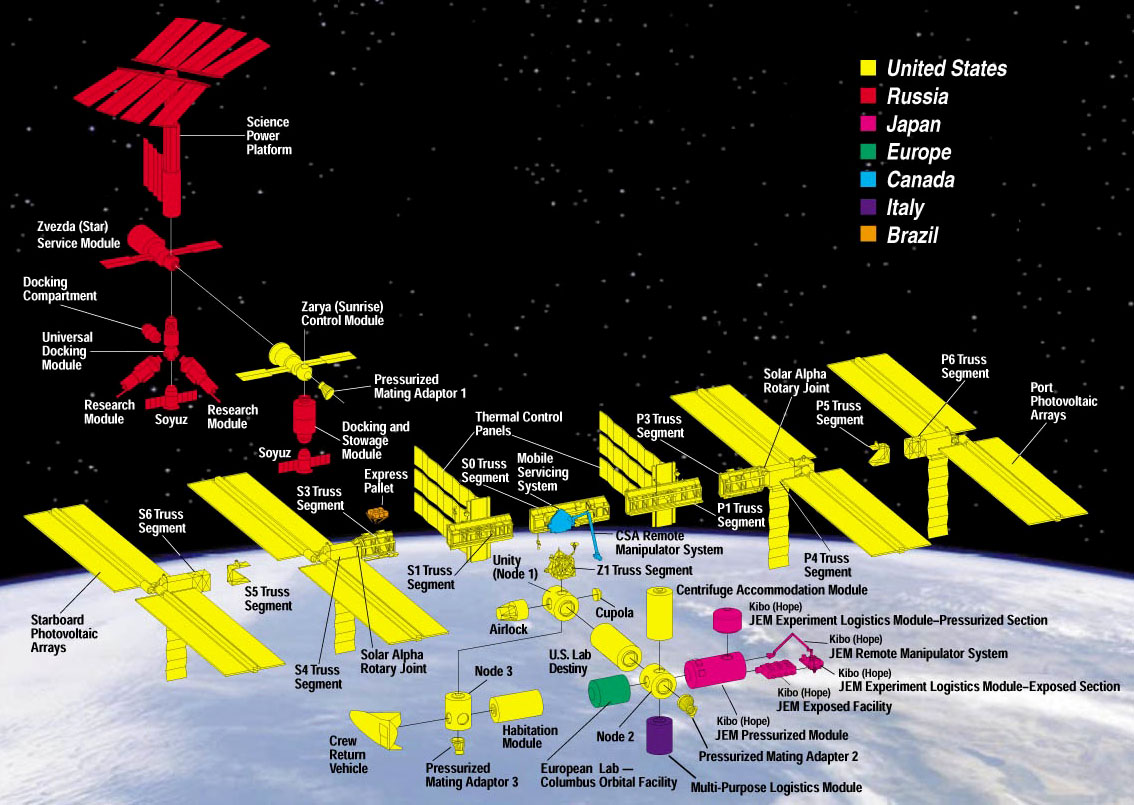Former Governor Gary Johnson (right) and CSSS President Jim Plaxco (left) at the Libertarian Party National Convention
By Jim Plaxco, June 03 2016
Elected to be an Illinois delegate to the Libertarian Party National Convention as a delegate supporting the Gary Johnson candidacy, I was presented with multiple opportunities to speak with former Governor Johnson over the course of the convention. Most of my discussions with him dealt with the commercial space aspects of national space policy. The policy positions I advocated were my own and not necessarily those of either the Chicago Society for Space Studies or the Space Development Steering Committee, both being organizations I mentioned in the course of our discussions. I specifically avoided mentioning that I was a NASA JPL Solar System Ambassador as that role had no relevance to the topics we discussed.
In establishing the importance of the commercial space industry, I pointed out that the global space economy had grown by 4 percent in 2013 and by an even more impressive 9 percent in 2014 (source: The Space Report 2015) – as compared to an overall global economic growth rate of 2.6% for 2014 (source: World Bank). This over-performance of the space sector versus overall economic activity is significant since growth of the space sector, which includes the civilian, commercial, and military sectors, is seen as being more sensitive than other economic sectors to the general level of economic activity. An analogy from the financial services industry would be a sector that has a beta coefficient that is greater than one.
The emergence of a significant commercial space sector combined with technological advances that not only lower costs but make a broader array of applications possible increases the probability that the space sector of the economy will continue to out-perform the broader economy on a percentage growth basis. Also worth noting is the outsized role of the aerospace sector in providing high quality jobs and contributing to a favorable balance of trade, with $144 billion in export sales in 2015. In fact, the U.S. aerospace industry leads the United States in the net export of manufactured goods (source: Aerospace Industries Association).
Having established an economic framework in our first conversation, I proceeded to specific policy points in our second discussion. Knowing that the next president will face significant budget challenges and knowing Governor Johnson’s views on government, regulation, and the private sector, I focused on points I was certain that we could agree on. These points were:
- FAA Regulation of the Space Tourism Industry
- NASA’s use of Space Act Agreements (SAA)
- Accelerating and Fully Funding Commercial Crew
- Replacing SLS/Orion with Commercial Alternatives
- Expansion of Private Access to ISS à la CASIS
- Exploring Commercial-Use Alternatives at ISS End-of-Life
FAA Regulation of the Space Tourism Industry
The Federal Aviation Administration Office of Commercial Space Transportation is the government agency charged with regulation of the commercial space industry. At present, space tourism is the most vulnerable sector of the commercial space industry and early over-regulation could lead to its collapse in the U.S. In raising this issue with Governor Johnson, my objective was to make him aware of the need to limit premature regulation of the space tourism industry. I emphasized that a cautious approach to regulation must be taken in order to give this new industry the opportunity it needs to establish itself as an economically viable sector.
Currently, a “light-touch” approach is implemented in the U.S. Commercial Space Launch Competitiveness Act. This legislation, introduced by Rep. McCarthy, Kevin [R-CA-23], was passed by the House and Senate and signed into law by President Obama in November 2015. This was an updated version of previous legislation whose protections were to end this year. The new legislation extends the period of protection through 2013.
NASA’s use of Space Act Agreements (SAA)
Flexibility in the procurement of goods and services for an organization is important and the principal tool providing this flexibility to NASA is the Space Act Agreement (SAA) option. Space Act Agreements are of a commercial nature and are not subject to normal Federal Acquisition Regulations (FAR) which have been shown to be costly from a procurement perspective. One example of this form of acquisition is the SPACEHAB Logistics Module.
SPACEHAB was a commercial venture that flew a pressurized logistics module in the Space Shuttle’s cargo bay and greatly enhanced the value of shuttle missions. SPACEHAB leased the cargo bay space from NASA and NASA in turn leased SPACEHAB locker space. SPACEHAB raised 200 million dollars in private financing to make the project possible. The U.S. Congress wanted to know if the government was getting a good deal so NASA was ordered to conduct an independent cost assessment. The conclusion of that study was that using the standard contracting methods that would have resulted in government ownership, as with the Shuttle, would have cost NASA and the taxpayers 1.2 billion dollars. It is doubtful that the U.S. Congress would have authorized this project if it had been proposed using the traditional government-ownership model and consequently all the research that was made possible because of SPACEHAB would have never happened. For the details of this Space Act Agreement, see the NASA document Nonreimbursable Space Act Agreement Between The National Aeronautics And Space Administration And Spacehab, Inc. For Commercial Space Transportation Capabilities PDF
Another example are the agreements associated with the Commercial Orbital Transportation Services (COTS) / Commercial Resupply Services (CRS) / Commercial Crew Development (CCDev) programs. With the Commercial Resupply Services program, NASA buys transportation services from private companies to help keep ISS supplied. With respect to the SpaceX Falcon-9, NASA investigated what it would cost to develop its own alternative to the Falcon-9. Falcon-9 was developed by SpaceX using private financing at a cost of around 400 million dollars. NASA estimated the cost to develop their own alternative launcher at just shy of 4 billion dollars. The savings realized by purchasing commercial services has greatly eased budgetary pressures on NASA, put downward pressure on launch costs for other government agencies, freed up financial resources for NASA to pursue other objectives, made the acquisition of a redundant system possible (Orbital ATK’s Antares launcher and Cygnus spacecraft), and strengthened our domestic space industry.
In raising the issue of Space Act Agreements, my objectives were to emphasize the value of SAAs both to the taxpayer, to NASA, and to the U.S. space industry.
Accelerating and Fully Funding Commercial Crew
I stressed to Governor Johnson the need to accelerate and fully fund the NASA Commercial Crew program. The key reason I gave was that until we have our own manned launch capability, we will be forced to continue purchasing these services from Russia – which strengthens their space economy at the expense of our own. Secondarily, dependence on Russia for crew access to the space station makes ISS hostage to any deterioration of relations between our two countries.
Unfortunately because of politics (in part the battle between SLS vs CC politicians), the Commercial Crew program has been seriously underfunded since its inception. For example, for FY2011 through FY2015 budget requests totaled 3,849 million but only 2,744 million was appropriated, about 70 percent of the total request. This underfunding has resulted in program delays and in extending the period of time for which the U.S. must pay Russia to ferry crew to the space station.
In Nov. 2013, the NASA Office of Inspector General issued the report NASA Office of Inspector General report: NASA’S Management Of The Commercial Crew Program. A few points the report made are:
- Between 2012 and 2017, NASA will pay Roscosmos $1.7 billion to ferry astronauts to and from ISS
- The program (Commercial Crew) received only 38 percent of its originally requested funding for FYs 2011 through 2013
- Under-funding over FYs 2011-13 may delay the first crewed launch to near-2020
With improved funding for FY2015 and full funding for FY2016, there is some hope that a first crewed launch date could happen as early as late 2017. At this time SpaceX is hoping for a late 2017 launch of its Crew Dragon / Falcon 9 system while Boeing is looking for a first launch date of February 2018 for its CST-100 Starliner / Atlas 5 system. NASA awarded the Commercial Crew Transportation Capability (CCtCap) contracts to Boeing and SpaceX in September 2014. For additional background, see NASA Commercial Crew Program – The Essentials
Replacing SLS/Orion with Commercial Alternatives
With respect to the duo of Space Launch System and Orion (SLS/Orion), I did not raise the issues of cost, flight rate, timeframe, or mission. Rather I emphasized that by the outright purchase and operation of its own launch system and crew vehicle, NASA was setting itself up as a competitor-to rather than a customer-of our domestic space industry. Taxpayers, NASA, and the U.S. space industry would all be better served if the federal government pursued commercial acquisition of these needed services. Past experiences with commercial procurement which avoided the imposition of Federal Acquisition Regulations (FAR) resulted in significant savings for NASA and the U.S. taxpayer. The dollars saved from the commercial procurement of goods and services were freed up and redirected to other areas, like research and development activities that could yield a far greater payback to the nation.
An important additional benefit is that having NASA become a customer for commercial services, the savings associated with economies of scale become more possible – which could become the foundation for the creation of a virtuous cycle. For example, in the interview “The Next Level” published in the March 14-27, 2016 issue of Aviation Week and Space Technology, Charles Elachi, Director of the Jet Propulsion Laboratory stated that for a lander mission to Jupiter’s moon Europa:
With the present launch vehicle, it takes at least 7.5 years to get to Jupiter, because we have to do a series of [gravity-assist] flybys. With an SLS we can do it in 2.5 years.
While use of SLS has been suggested as a launch vehicle for missions to the outer solar system, at present there are no frim plans or committments for SLS to be used for launching planetary science missions. A further serious complication is the current estimated flight rate of just one launch per year. For more on the issue of the SLS mission, see the article
Kennedy Space Center meeting portrays SLS as scrambling for a manifest plan.
Given that the market today for Saturn V class heavly-lift vehicles is very limited, if not non-existent, the optimal course of action would be for NASA to become an “anchor tenant” for a commercially provided heavy-lift launch vehicle. By having NASA and other U.S. government agencies as a customer of what would certainly be a far less costly rocket to space, perhaps a more sustainable and practical launch rate could be maintained. The availability of such a commercial launcher might also become an attractive launch option for non-U.S government agencies and other commercial space endeavors.
Expansion of Private Access to ISS à la CASIS
In 2005, an act of Congress declared the U.S. portion of the International Space Station (ISS) to be a national laboratory available for research use by various government agencies as well as for academic and private institutions. In 2010, Congress authorized NASA to identify a nonprofit whose mission would be to manage the ISS U.S. National Laboratory and in 2011, the Center for the Advancement of Science in Space (CASIS) was selected for that role.
While there have been concerns raised as to the efficiency of this specific pubic-private implementation, the Government Accountability Office 2015 report
INTERNATIONAL SPACE STATION Measurable Performance Targets and Documentation Needed to Better Assess Management of National Laboratory does state that:
The ISS offers the potential for scientific breakthroughs, a unique test bed for new technologies and applications, and a
platform for increased commercial and academic research. Achieving greater utilization of the ISS and its unique
capabilities, showing the benefit of commercial and academic research, and demonstrating success to generate increased interest from potential users could help NASA get a better return on its significant investment in the ISS.
The point I stressed with Governor Johnson is that there may be other areas of ISS research, operations, and management that could benefit from implementing a similar public-private partnership approach.
Exploring Commercial-Use Alternatives at ISS End-of-Life
Currently, NASA’s plan is to destroy the 120 billion dollar International Space Station upon its end-of-life (EOL) date by deorbiting it. This end-of-life date is arbitrary in the sense that it is primarily driven by budgeting rather than system performance.
International Space Station (ISS) System Components illustration (click to enlarge)
Instead of simply deorbiting and destroying ISS once its mission is declared over, the first consideration should be to explore the possibility of full privatization of ISS. Only if privatization or reuse options are not feasible should ISS be destroyed.
Space Policy Summary
My third conversation with Governor Johnson with respect to space policy was a recapitulation of the points I had made previously. I also stressed that the Johnson for President campaign needed to issue a space policy position paper. The issuance of a space policy position paper is made all the more important by the lack of any mention of space policy in the Libertarian Party platform. A space policy position paper would clarify for those voters with a strong interest in space and aerospace the candidate’s positions on the subject.
In closing, while in other discussion on issues unrelated to space I could see that Governor Johnson’s position differed from my own, I did not perceive any such disagreement on the subject of support for commercial space activities and an expansion of the procurement by NASA of commercial alternatives. And I must add that while I did discuss with Governor Johnson all the points presented in this article, I have in places provided additional commentary (and references) that was not a part of our conversations. The purpose of these additions are to provide the reader with a broader understanding of the issues being discussed.
Additional References
ISS End-of-Life (EOL): NASA and Roscosmos discuss ISS suicide plunge requirements
Space Industry: U.S. Space Industry Deep Dive Assessment : Impact Of U.S. Export Controls On The Space Industrial Base – 2014
Space Industry: Aerospace Industries Association 2014 Year-End Review And Forecast PDF
Space Launch System: NASA officials admit Space Launch System is a rocket without a plan
FAA Commercial Space Report: FEDERAL AVIATION ADMINISTRATION Commercial Space Launch Industry Developments Present Multiple Challenges
GAO NASA Assessment Report: United States Government Accountability Office Report: NASA Assessments of Major Projects Report to Congressional Committees, March 2016


